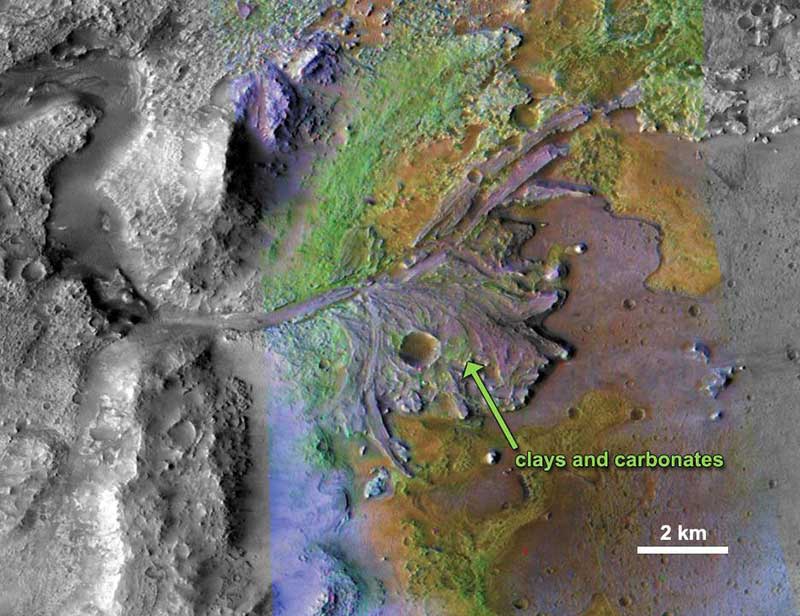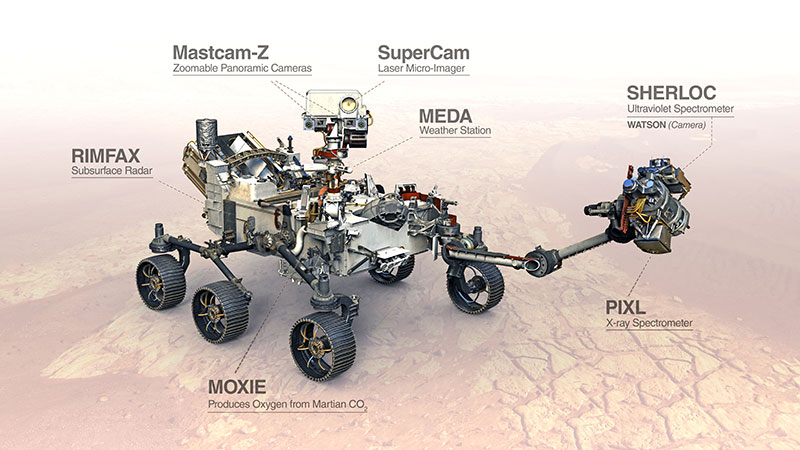After the success of Curiosity, a new Mars rover Perseverance is on the planet’s surface and specifically looking for signs of life. Anthony King reports.
On 18 February 2021, amidst a global pandemic, the largest human object to ever land on an alien planet touched down on Mars. The car-sized robot Perseverance is equipped to probe the geology of Mars and seek signs of ancient life. In a hugely ambitious mission, it will cache rock samples for their eventual return to Earth, in collaboration with the European Space Agency (ESA). In 2022, a Russian-European mission to Mars called ExoMars will launch another rover towards the planet.
‘These are halcyon days for Mars exploration,’ says John Bridges, planetary materials researcher at the University of Leicester and participant in European and US missions to explore the red planet.
Perseverance builds on the Mars Science Laboratory mission, which landed in August 2012. The 900kg Curiosity rover arrived inside Gale Crater, on what looked like an alluvial fan formed by clay sediments carried by water, bringing with it a robotic analytical lab to investigate samples in situ.
Curiosity showed that conditions compatible with life once existed on Mars, says Bridges, who is part of this mission. ‘We found over 400m thickness of more or less fine-grained lake deposits, which requires a pretty stable body of water for millions of years,’ he explains. Indications are that lake water at Gale Crater was not particularly noxious, with a reasonable acidity. There was also carbon, hydrogen, nitrogen, oxygen, phosphorus and sulfur, with temperatures hospitable for life.
‘Mars has the right stuff. We’ve demonstrated that now, particularly with the Curiosity measurements,’ says Raymond Arvidson, a planetary scientist at Washington University in St Louis, US, and member of the Mars Science Laboratory’s Curiosity rover mission. ‘It would have been chock full of life, if terrestrial microbes were there.’
Curiosity and preceding missions answered the first big question in the affirmative – yes, there could have been life on Mars. NASA extended Curiosity’s mission indefinitely in 2012 and as of October 2021, the rover has been operating for over 3000 Martian days.
‘Curiosity not only confirmed there was a lake of water that once existed at its landing site and Gale Crater, but it also discovered complex organic molecules that were present at that site,’ Lori Glace, Director of NASA’s planetary science division, told the AAAS meeting in February 2021.
The Mars Global Surveyor, a robotic probe launched in 1996, had a magnetometer that revealed that the oldest Martian rocks were magnetised, until about 3.8bn years ago. But this changed, potentially with catastrophic consequences for any Martians. It is believed Mars, a smaller planet than Earth, quickly lost heat from its metal-rich core and mantle. ‘The interior cooled pretty fast and put the whole planet into a deep freeze,’ says Arvidson. Once the core cooled and froze, there was no longer a magnetic field to protect the Martian atmosphere, and the solar wind stripped it away to what we have today – an atmosphere 100 times less dense than Earth.
The loss of a protective atmosphere turned the planet into a colder and more inhospitable environment. Also, Mars is one and a half times further from the Sun than Earth, so it would have needed an efficient greenhouse atmospheric blanket to retain enough heat to maintain liquid water on the surface. While Mars has been a tough environment for life for billions of years, its early history was much more favourable. The next big challenge is to search for signs of microbial life in rocks from this period of a wetter, warmer Mars.
3000
NASA’s Curiosity rover, which landed on the planet’s surface in 2012, has been operating for over 3000 Martian days.
100x
About 3.8bn years ago, Mars lost heat from its metal-rich core. There was no longer a magnetic field to protect the atmosphere, and the solar wind stripped it away to what we have today – an atmosphere 100 times less dense than Earth.
Perseverance collects surface samples using a rotating drill and a smaller arm that picks up and moves material into one of 43 airtight titanium tubes. The samples will be placed on the surface of Mars, for a subsequent fetch rover mission to collect.
Perseverance pays
Perseverance is the first rover with the explicit goal of searching for signs of ancient life on Mars. It carries a special suite of instruments to look for biosignatures in Jezero Crater, where orbiter data suggests silt and sediment were deposited in a delta. The crater was chosen as the landing site – the most dangerous ever tried on Mars – because river channels spilled over the walls of a crater, more than 3.5bn years ago. A compact spectrometer on the Mars Reconnaissance Orbiter revealed the crater contains clays that form only in the presence of water.
Chemical alteration by water, Jezero Crater Delta (from Mars Reconnaissance Orbiter)
Jezero Crater: NASA/JPL-Caltech/MSSS/JHU-APL
‘Carbonates precipitate out of the water as a mineral and actually trap whatever is living there,’ said Briony Horgan, a planetary scientist at Purdue University, US, speaking at a NASA online prelaunch discussion in January 2021 (youtube.com/watch?v=70rKVFNtV7c). ‘If microbial life was present on the surface of Mars, this is exactly the kind of deposit where that type of life would be preserved.’
Perseverance was dropped west of the delta and will now move into the crater, collecting specimens on a 20km plus route, driving three times faster than any previous Mars rover. It also has a helicopter, Ingenuity, which carried out the first controlled flight on another world in April 2021. ‘It can reconnoitre ahead of the rover. That’s incredible,’ remarks Paul Byrne, planetary scientist at Washington University in St Louis, US.
The rover’s first sample was collected in September 2021 and placed into an airtight titanium sample tube for eventual return to earth. There are 43 sample tubes to be filled using a rotating drill and a smaller arm that picks up and moves the samples to a container. These samples will be placed on the surface of Mars, for a subsequent fetch rover mission – to be launched 2026 – to collect. The plan is to then send them into orbit using a spacecraft, which must rendezvous with a large craft to take them back to Earth in the early 2030s. ‘If it sounds complicated, it is,’ said Glace, during the January NASA online presentation. NASA expects these samples to be analysed for decades afterwards.
‘Searching for biosignatures is incredibly difficult and requires detailed measurements. The best place to do those are in a lab on Earth,’ Arvidson explains. ‘We can put them in laboratories on Earth, and even big facilities like the Diamond [Light Source] synchrotron, which we couldn’t possibly take to Mars,’ says Andrew Coates at University College London, UK, a physicist on ExoMars 2022.
According to NASA, microbial life could have lived in Jezero through its wet and warmer history. The rover will seek signs of this life, whereas previous missions gave glimpses of this possibility. What these biosignatures will look like is an open question. ‘The easiest thing would be to find microfossils, visual evidence, but that’s hard. These little guys are no more than a few micrometres across [on Earth],’ says Arvidson.
Another possibility is to find complex organic compounds, phospholipids or amino acids, especially if they display chirality (handedness) – on Earth, all amino acids characteristic of life are left-handed. ‘Usually, you are looking for complex organic molecules, or proteins, or at least fossilised versions of them,’ says Byrne. Or it could be distinctive layering in deposits, as seen in the ancient stromatolites (cyanobacteria) in Shark Bay, Australia. Even on Earth there can be lively debates about whether rocks 3bn plus years old contain signs of ancient life, or mineral structures that just look that way. ‘It won’t be just one piece of evidence,’ says Bridges.
One specific finding has intrigued planetary scientists. Curiosity has repeatedly detected methane above the surface of Gale Crater. Yet ESA’s ExoMars Trace Gas Orbiter has not detected this simple hydrocarbon higher in the Martian atmosphere since it began sampling in 2016. The tunable laser spectrometer on Curiosity recorded less than 0.5ppb of methane on average in the crater, but with spikes of 20ppb. Methane could be produced in three ways, says Arvidson: it could leak out onto the surface from serpentine rocks; it could be from unknown volcanic sources; or it could be from life. It’s a mystery that could even hint at something more dramatic, says Coates. ‘With the methane which has been sporadically seen in the atmosphere and also at the surface, there’s a chance that there is extant life.’
Mars has the right stuff. We’ve demonstrated that now, particularly with the Curiosity measurements. It would have been chock full of life, if terrestrial microbes were there.
Raymond Arvidson planetary scientist at Washington University in St Louis
Rosalind Franklin
Coates is involved in the ExoMars mission to Mars, scheduled for launch in September 2022, with arrival expected in June 2023. It will deliver the Rosalind Franklin rover onto Oxia Planum – one of the largest exposures of rocks on Mars dated around 3.9bn years old. Uniquely, this rover will be equipped to drill down 2m below the surface to collect a rock sample. The reason to go deeper is that the surface of Mars is incredibly harsh. The thin atmosphere means it is bathed in destructive ultraviolet radiation and cosmic rays. InSight, which landed in 2018, tried to bury a probe to measure heat flow, but failed to dig deep enough.
‘Drilling this deep gives us a chance to sample more pristine material,’ explains Coates, who leads the PanCam camera instrument on the Rosalind Franklin. The drilled material will be analysed with a gas chromatography mass spectrometer (GCMS) and a Raman spectrometer. ‘By looking at mineral assemblies in rocks, for instance, with the Raman on ExoMars, we can piece together things like temperature and relative abundances of different minerals,’ says Bridges.
The landing zone seems to be an ancient river delta. ‘This particular area was bathed in water for some time,’ says Coates. The northern regions of Mars might even have been home to a liquid ocean, around 3.8-4bn years ago, and this area could have been on the shores of that ocean. ‘This gives us an exciting prospect of looking back on Mars at exactly the time life was starting on Earth. So we’re looking for biomarkers that indicate signs of life starting on Mars, probably independently of Earth.’
20ppb
The tunable laser spectrometer on Curiosity has detected methane levels at less than 0.5ppb in the Gale Crater, but with spikes of 20ppb.
Right now, there are 11 different missions on Mars. This includes the first rover from China, the solar-powered Zhurong, which arrived in May 2021. The ExoMars rover will be the first time, however, scientists have glimpsed what lies further beneath the surface. ‘There is a chance that there could be extant life there, and if there is, we will find it,’ says Coates. ‘The likelihood is that it is not, because 3.8bn years is a long time since Mars began losing its atmosphere.’ But he adds that Mars had been viewed as a dead planet, until the signs of methane, which are ‘quite amazing’ because ‘it means it is more alive geologically speaking, or possibly these are signs of extant life.’
Nonetheless, that water existed on Mars for long enough for life to have emerged is not a given. ‘Not everyone agrees Mars was warm and wet [for life],’ says Byrne. Some say this ancient time-period was mostly cold and dry like today, but with periods of water for thousands or hundreds of thousands of years. Periods of extreme volcanism might have put a lot of CO2 into the atmosphere, blanketing and warming the planet for a time, or huge cometary impacts may have delivered lots of water and ice. ‘But certainly, there were standing bodies of water for some periods of Mars’s history,’ affirms Byrne.
Arvidson, who was involved in the 1970s Viking missions to Mars, predicts that if signs of ancient life turn up, there will be scientific expeditions, just as humans ventured to the frozen wastes of Antarctica. Perseverance also has MOXIE (the Mars Oxygen In-Situ Resource Utilization Experiment) that will prepare for human explorers by demonstrating how oxygen could be generated from CO2 in the atmosphere using electrolysis. This oxygen could serve as a propellant for rockets and for breathing. Other instruments on the rover will help inform future journeys of astronauts there, according to NASA.
The Mars research community is excited about the future. ‘What has surprised me is just how Earth-like Mars once was, now that we’ve gone to the landing sites, and seen the full richness of the ancient warm and wet environment,’ says Bridges. ‘It would be fascinating if we did find ancient deposits of life on Mars – and also if we didn’t, since it would tell us perhaps how unique Earth is.’
Rover diagram: NASA/JPL-Caltech
Hero image caption: An illustration of NASA’s Perseverance rover exploring inside Mars’ Jezero Crater. A key objective is the search for signs of ancient microbial life. Image credit: NASA/JPL-CALTECH







